The Gold Bears Need To Start Writing Their Last Will And Testaments
The people who are looking at the gold market as if it's a deflating bubble are ignorant, or more likely ignorant and lazy. To prove my point, I took weekly closing prices for the Dow Jones, NASDAQ and the price of gold, starting from the first week of their bull markets: August 1982 for the Dow Jones and the NASDAQ, February 2001 for gold. I then indexed their prices so they all start at 1.00, and plotted them by the number of weeks since the start of their bull markets. The Data for the stock indexes runs from August 1982 to February 2002, so we don't see their peaks in 2007.
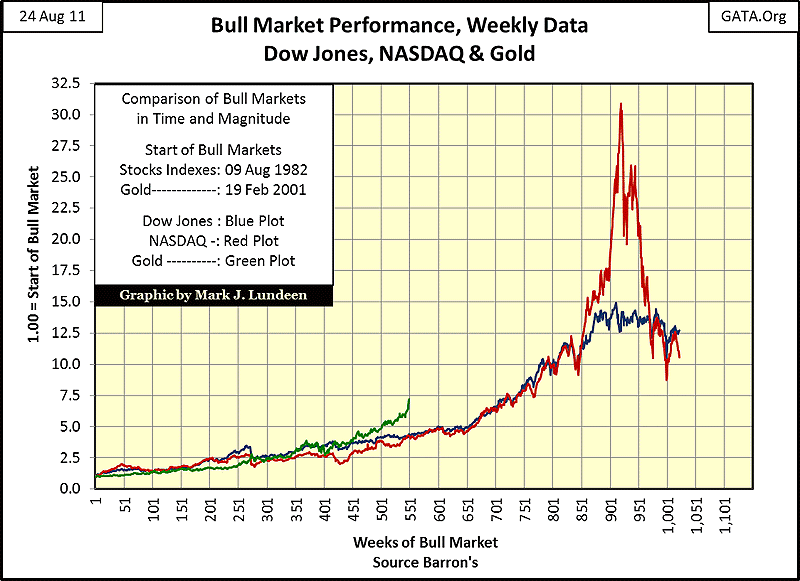
When comparing three indices' bull markets to each other at Week 549:
- 08 Feb 1993 issue of Barron's for the stock market
- last Friday's close for gold
Obviously gold has outperforming the Dow and the NASDAQ at this time, but not by much. The price of gold (my green plot above) must go much higher before we can even think of it as being overvalued. Gold would have to increase to about $8000 dollars to achieve the gains of the 2000 NASDAQ Composite.
Also, this week gold is in the news for being down a few percentage points. Well, how bad was this week for the gold bulls? We can find the answer to that question when we do a Bear's Eye View (BEV) analysis of the gold market. Remember, BEV charts compress data into a confined percentage range spanning from 0% for each New All-Time Highs of a bull market, down to -100% for a total bear-market wipeout in valuation.
The Bear's Eye View is just that, as each time the bulls see a new all-time high, it's a big-fat ZERO as far as Mr Bear is concerned. So in the following BEV charts, each BEV 0% indicates the temporary victories of the Bulls, while the negative percentages tells us how successful Mr Bear was in clawing back the bulls' profits after each new all-time high.
Looking at my first BEV chart, this week's decline looks phony as hell. One day gold is at a new all-time high, two days later it "plunges" 7.12%. I'm not impressed.
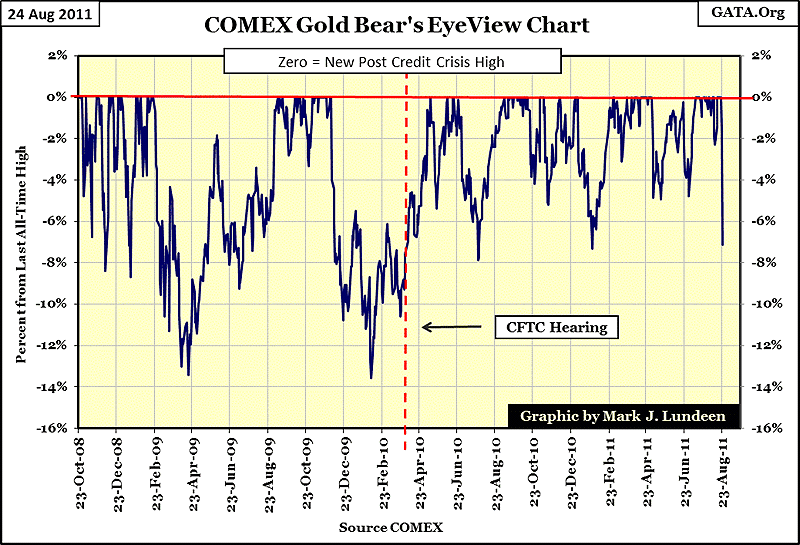
Let's see if Lefty and Knuckles can beat another 7% out of gold, and make this the sharpest correction it's seen since October 2008. But I must note that historically, even a 20% correction in gold bull markets is no big deal. Let's look at gold's BEV Plot during its 1969 to 1980 bull market. Gold during these eleven years had only one price correction * less than * 15%, which I circled below. Remember, after January 1980, gold began a 21 year bear market.
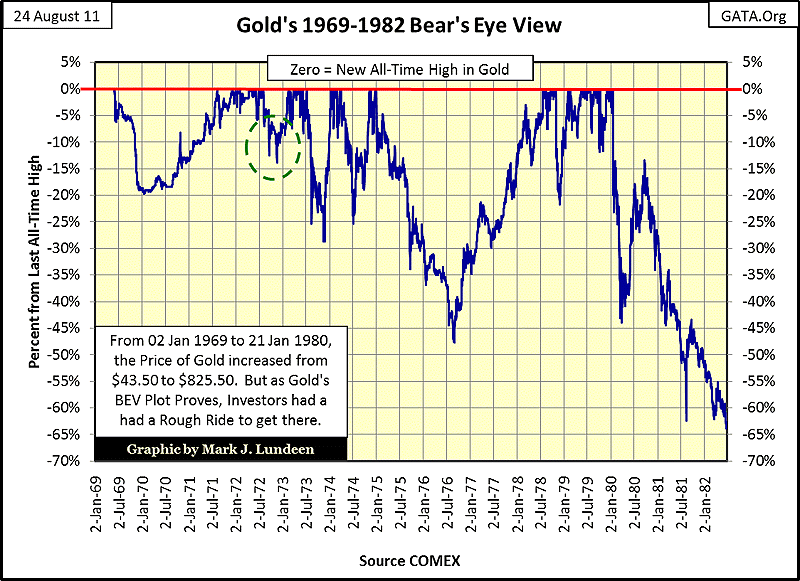
The current bull market in gold has continued as long as the 1969-80 bull market. But when we compare their two BEV plots to each other, we see that our gold bull has been a volatility pussy-cat compared to the 1970s bull - so far.
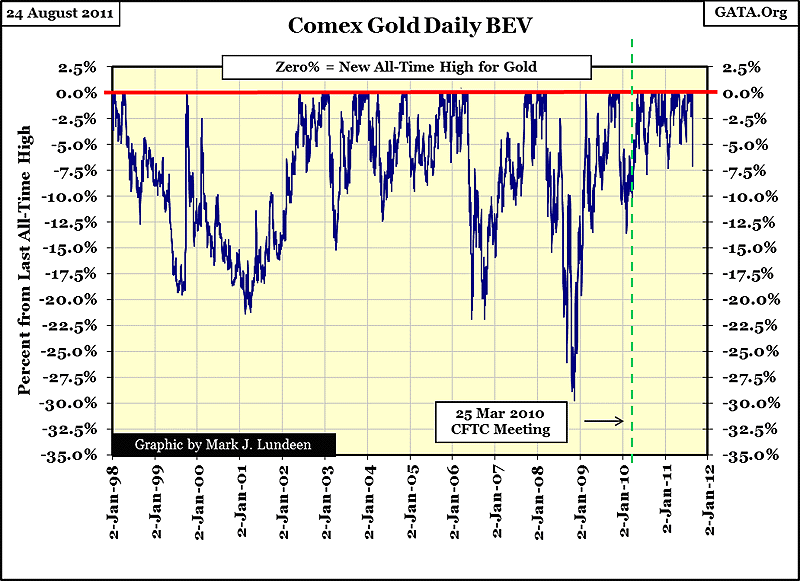
When one considers the real reason gold and silver have risen since 2001 - twenty years of financial sewage backing up, and spilling out onto Wall Street, would even a 30% decline in the next few weeks make much difference in the price of gold a year from now? Not with Doctor Bernanke giving his big Jackson Hole speech on Friday. What's that little rascal going to propose; that the Fed's open market committee will cease empting its bowels on everyone's net-worth? NO WAY! If gold is less volatile in our current bull market than it was from 1969-80, there are a few hundred-trillion reasons in the derivative market alone why this is so.
We'll have to wait until Friday to see how the good Doctor intends to maintain the faint pulse in the economy and financial markets. But no matter what he intends to do, we can all count on CNBC doing their best to spook gold and silver investors out of the market.
However, when shares of Bank of America and other financial stocks see similar percentage declines as gold did this week, CNBC seldom even bothers to mention it. In fact, just last week they gave the CEO of Bank of America plenty of air-time to reassure investors (and depositors) that things are looking up for the Bank that Treasury Secretary Paulson, in 2008, used as a toxic waste dump for Wall Street's sub-prime mortgages. Remember Country Wide Finance and Merrill Lynch's ticker symbols? No need; as they both have moved to a new address at the NYSE: BAC.
Merrill Lynch had for many years been the largest brokerage in the world, now it's just another casualty of the Fed's lax monetary policy. Countrywide grew in just a few years from a primary business model of buying up and securitizing mortgages from other originators, to a gigantic bloated originator, servicer, and securitizer of mortgages of declining credit quality until it finally blew up and had to be rescued by BofA (Thank you Secretary Paulson) just as it reached the point of complete insolvency, and failure was inevitable. Then, last week, we saw rumors circulating among the financial press that BofA was going to be "purchased" by JP Morgan.
So let's see if I've got this straight: The giant monolith JP Morgan Chase (2nd largest US mortgage lender in 2008, and largest US commercial bank in 2011) was rumored to be about to gobble up the 2nd largest US commercial bank in 2011, BofA (also, the 3rd largest US mortgage lender in 2008), which had recently gobbled up the (former) world'slargest brokerage firm (Merrill Lynch), and Countrywide (largest US mortgage lender in 2007, and the largest subprime lender), not to mention JPM has also gobbled up Washington Mutual and Bear Stearns.
Washington Mutual (Wamu) was at one time the largest savings and loan in the US, and had acquired many other lenders over the years including American Savings & Loan (largest in CA), and Long Beach Savings which was the fifth largest subprime lender during the mortgage debacle, (and 50% of the loans they made between 2005 and 2007 have since gone into foreclosure). Wamu had been the third largest mortgage lender in the US in 2005, and Bear Stearns had also become a large mortgage lender in the decade since Glass-Steagall was repealed (on the recommendation of Doctor Greenspan and Treasury Secretary Robert Rubin) by an overwhelming majority vote in 1999. Apparently, the Sherman Antitrust Act has become one big meaningless joke in this country, and shame on the Department of Justice for not enforcing it! But we should all note that the Justice Department has ample personal and man hours to discipline Standard and Poors for their lack of team spirit.
I'll give the gold bears a really scary concept: go back to my first chart, and have a look at the gains in the Dow and NASDAQ. What do you think their ultimate 2000 highs would have been if Wall Street had the self-control to resist the orgy of new IPO's in the chart below? I haven't a clue, but the Dow and NASDAQ Composite would have gone much, much higher. Since the 2000 top, how many of the NASDAQ fallen are languishing in the pink sheets, and many have just disappeared with the money retail investors invested in them?
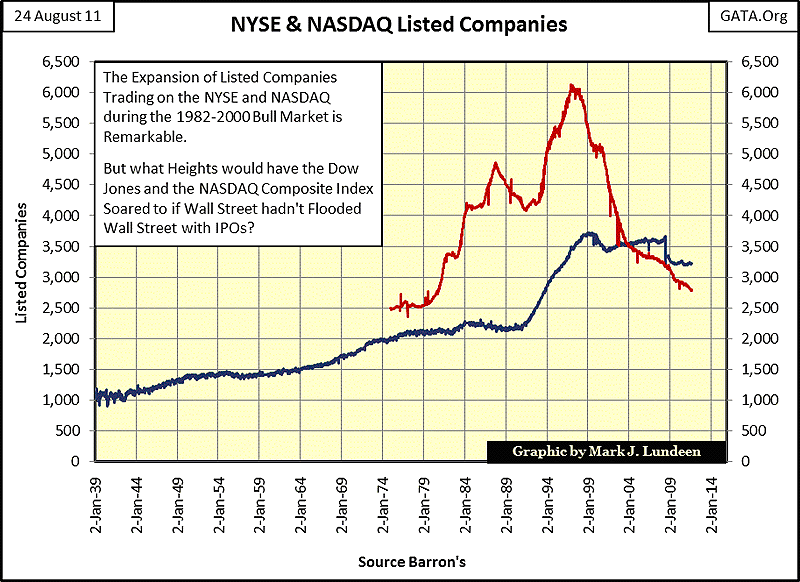
Let's face it; the price of anything depends on supply and demand. Wall Street during the 1990s was inflating the supply of companies trading on Wall Street with one bogus IPO after another, greatly diluting the effect of rising investment demand on share prices from 1990 to the 2000 top. But physical gold, unlike gold futures, or the number of companies listed on the stock exchange, cannot be brought into existence by doing the necessary paperwork. In fact, the availability of actual gold only increases by about 2% a year. There is only so much gold (and silver) available, and that's all there is.
Dennis Gartman, who feels (pathetically) obliged to constantly remind everyone that he is no gold bug, recently brought to everyone's attention that all the gold mined for the past 5,000 years would fit into a cube some 64 feet cubed. Think of this: all the gold in the world would fit inside a base-ball diamond with plenty of room to spare.

Not to forget silver, there is even less above ground silver than there is gold! Wow! The "in-field" of Yankee Stadium isn't much space for the global investment community to squeeze into when the bottom falls out of American and European financial markets.
For you gold and silver bears out there who for "policy reasons" can't close out your short positions; think about that! It really isn't too early to start writing your last will and testament.
[email protected]

















